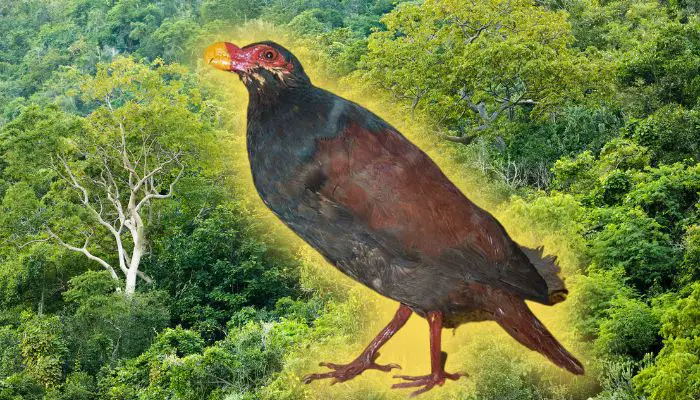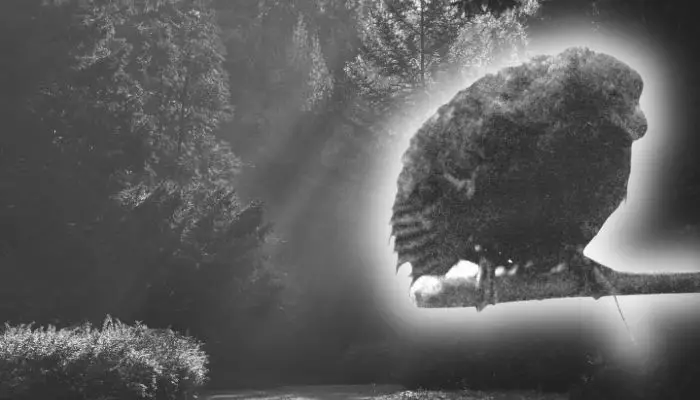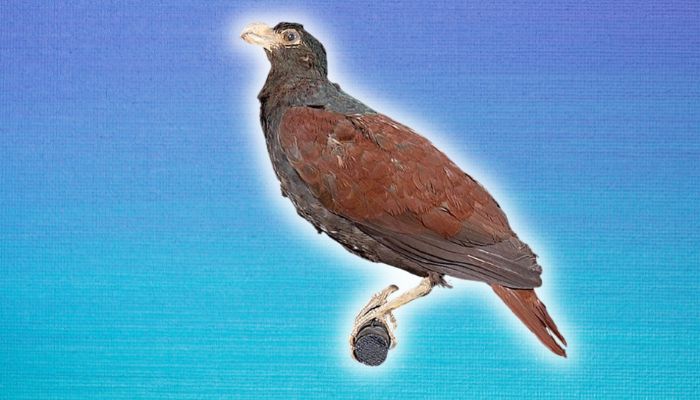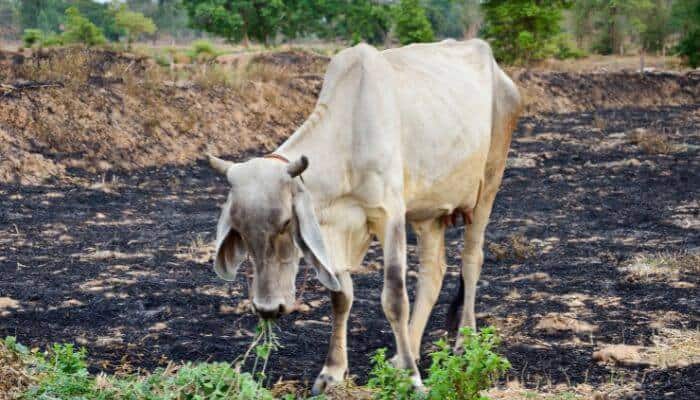The Tooth-Billed Pigeon is a large fruit-eating pigeon that is native to Samoa, in the central South Pacific. This rare wild pigeon species is Samoa’s national bird and is actually listed as Critically Endangered on the IUCN Red List.
Although known as the Tooth-Billed Pigeon across the world, these non-migrant pigeons are known by the name “Manumea” in Samoa where they are found.

As one of the closest living relatives to the extinct Dodo, the Tooth-Billed Pigeon is also nicknamed the “little Dodo”.
Origins of the Tooth-Billed Pigeon
The Tooth-Billed Pigeon (Didunculus strigirostris) is endemic to Samoa and is the only species of the Didunculus genus.
This species is related to the Tongan Tooth-Billed Pigeon, an extinct species known only from partially fossilized remains.
Tooth-Billed Pigeons were likely discovered in late 1839 by the United States’ Exploring Expedition. In September 1844, the discovery of the Tooth-Billed Pigeon was announced as one of the species obtained by the naturalist of the expedition, Mr Titian Peale.
It was a year later, in July 1845, that the first official description of the Tooth-Billed Pigeon was released.

The description was written by Scottish naturalist William Jardine, he described the Tooth-Billed Pigeon as the size of a “common stock dove” and wrote the birds had a “very strong hooked bill and remarkable teeth displayed in the mandible”.
The original description of the species by William Jardine used the name Gnathodon strigirostris, a genus that was already used for a mollusc.
As the species is genetically similar to the dodo, the genus name Didunculus meaning “little dodo” was given.
Distribution & Habitat of the Tooth-Billed Pigeon
The Tooth-Billed Pigeon is found only in Samoa’s undisturbed primary forests, they are rarely seen and little is known about the ecology of the species.
These pigeons live in primary forest from sea level up to 1,600m and are found only on the Samoan islands of Upolu and Savai’i.

They do not migrate and the remaining population is believed to be heavily fragmented.
Due to degradation and agriculture, the habitat where these pigeons live is being depleted which is contributing to the population decline.
The population was estimated to be between 4,800 – 7,200 individuals in the mid-1980s but this figure has dropped drastically with the estimated number of a 2005-2006 survey being just a few hundred.
A 2016 survey produced only one definite detection of the Tooth-Billed Pigeon in the Uafato forest. It is believed there are between 70-380 individuals remaining in the wild.
Tooth-Billed Pigeon Appearance
| Wingspan | Length | Weight | Coloring | |
|---|---|---|---|---|
| Tooth-Billed Pigeon | Unknown | 31 – 38cm | 400g | Red, grey, iridescent blue-green |
| Average Feral Pigeon | 64 – 72 cm | 32 – 37 cm | 300 – 500 g | Bluish grey with some black |
The Tooth-Billed Pigeon is a medium-large pigeon that is recognizable by its heavy, hooked red bill and dark plumage.

These pigeons have dark-colored grey feathers (with a blue-green iridescence) on their head, neck, and underside.
The tail, wings and tertials are a rufous chestnut and they have bare red skin around the eye as well as reddish feet.
One of the most distinguishing features of the Tooth-Billed Pigeon is their large, curved bill that is bright red and hooked at the end.
The lower mandible of the bill also has tooth-like projections, which is what the species name refers to. The structure of the bill is essential to the pigeon’s feeding and diet.
The males and female Tooth-Billed Pigeon are similar in appearance although the females are thought to have less iridescence than the males.
The juvenile Tooth-Billed Pigeon has a browner head and a black bill with a pale orange base, giving them a duller appearance overall.
Facts About The Tooth-Billed Pigeon
- The Tooth-Billed Pigeon is found only in Samoa
- They are a relative of the extinct Tongan Tooth-Billed Pigeon
- The Tooth-Billed Pigeon is the national bird of Samoa
- Local currency features these pigeons (specifically 50 sene pieces and 20 tala bills)
- Tooth-Billed Pigeons are called Manumea in the local language of the Samoan regions, and means “red bird” or “precious bird”.
- These pigeons are one of the closest living relatives to the Dodo.
Tooth Billed Pigeon Conservation
Tooth-Billed Pigeons are listed as Critically Endangered on the IUCN Red List.
Their declining population is due to a number of factors including habitat loss, small population size, hunting, limited range, and damage caused by cyclones.
Habitat loss is one of the key drivers behind the decreasing population of Tooth-Billed Pigeons, it is thought the remaining population is severely fragmented due to forest degradation and habitat loss.

In Samoa, agricultural expansion is one of the key drivers of direct habitat loss and there are several causes of habitat degradation including invasive tree species and cyclones.
The forest is continuing to decline which is putting increasing pressure on the remaining Tooth-Billed Pigeon population.
Hunting is also considered a key threat, although the Tooth-Billed Pigeon isn’t a primary target they can be accidentally killed when Pacific Imperial Pigeons are being hunted.
Pacific Imperial Pigeons are much more common and are often a target for hunters on the islands.
Another issue is the damage to the environment caused by feral cats and rats. This is an ongoing threat that is potentially worsening due to increasing cat and rat populations.

The Tooth-Billed Pigeon is at risk of extinction and there are only believed to be between 70-380 of these pigeons remaining in the wild.
The last sighting of this elusive pigeon was in August 2020.
Although there are remote areas of forest that have not been surveyed that could be home to these pigeons.
There is a lot of information yet to be collected on these birds and there are no Tooth-Billed pigeons in captivity.
Key Conservation of the Tooth-Billed Pigeon Include:
- Protecting the birds by law
- Banning hunting
- Researching the species habitat preferences and breeding biology
- Researching the birds’ distribution, population, habitat requirements etc.
- Managing key forest areas and the removal of cats and rats (proposed action)
To save the Tooth-Billed Pigeon from extinction there needs to be more knowledge of the population and why they are declining as well as pest control, protecting the remaining forests as well as conservation education to reduce hunting.
Tooth-Billed Pigeon Character
Very little is known about the character of the Tooth-Billed Pigeon.
Generally, they are considered to be shy birds that are often silent although they do sing sporadically during their breeding season.
Tooth-Billed Pigeons are believed to live in small parties.
When looking for a mate, the male has an advertising call that he makes from a treetop. This is a short call that lasts just a couple of seconds.
Something Tooth-Billed Pigeons do that many other bird species do not is that they use their feet to hold food down while they peck off pieces, they also scoop water into their bill to drink rather than using their tongue.
There are no Tooth-Billed Pigeons in captivity and they are not considered to be a good pet so there is not a lot known about these elusive birds.
Diet
Tooth-Billed Pigeons are specialized feeders and their bill is perfectly adapted to being able to saw through tough seeds of the Dysoxylum tree (part of the mahogany family).
This means they have no competition for food.

The pigeons are able to hook the hard seed from the Dysoxylum and then use their lower mandible to remove the flesh.
In addition to this, Tooth-Billed Pigeons eat fruits and plants. Locals have reported the birds prefer Ma’ali and Maota fruiting trees out of over 20 fruiting tree species.
The pigeons have also been seen feeding on the ground on occasion.
Mating And Breeding Tooth-Billed Pigeons
Very little is known about the mating and breeding of these rare pigeons. However, it is thought that the Tooth-Billed Pigeon lays two eggs during the breeding season.
A Tooth-Billed Pigeon’s nest has never been documented but in 1987 nests were reported 5-25m up in dense foliage.
The nests are often associated with banyan trees and epiphytes but there is still a lot to learn about these birds and their breeding.
As juveniles are not able to open seeds until their bills have properly developed it is thought they may feed disproportionately on the ground until they can saw through the tough Dysoxylum seeds.
In the 1800s, manuscripts suggest the Tooth-Billed Pigeon chicks are confined to the forest floor but this is unconfirmed.
As the Tooth-Billed Pigeon is incredibly elusive and has no close living relative there is still lots we do not yet know about this species.
Caring for Tooth-Billed Pigeons
The Tooth-Billed Pigeon is a wild species, there are none in captivity and the birds are not suitable for domestication.
The best way to help care for the Tooth-Billed Pigeon is to help protect their habitat and support conservation efforts.
The Tooth-Billed Pigeon is one of the most endangered species in the world and is disappearing at an alarming rate.
Conservation actions are needed to stop this species from going extinct.
